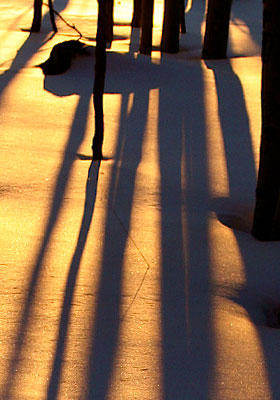Archive for the ‘happiness’ Category
Monday, January 11th, 2016
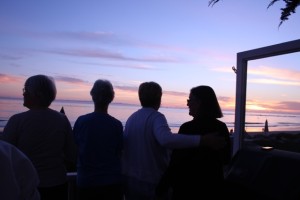
I’m visiting family and marveling at how long my grandchildren’s arms and legs have grown, how my daughter has become an inventive and creative cook, and how my ex husband has turned into a gentle friend. As this year just begins to unfold, I’m aware of the longer arc, and of the graceful way life changes the way the path looked …way back then.
I’m reminded of the story of how an apparent tragedy occurs, only to become s portal for a fortuitous event, that then morphs into the doorway for another downturn. Age at least provides a lens for the long story, and presents an option not to get too caught up in the drama and apparent truths of each chapter of this wild and beautiful journey.
On this annual solo road trip, I visit family, see old friends, and will end up with seven close women friends who have been a group for over 35 years. We’ve watched each other meet obstacles, embrace blessings, and survive dramas great and small. Perhaps to balance out the complexity of our own sagas, we always pepper our reunion with as many movies as possible, separated by walks on the beach, home cooked food and less wine than we used to drink.
In our seventies, we know we face losses in the upcoming episodes of our reunion series. One of us has already lost a partner to a sudden, deadly heart attack. Another is recovering from a knee replacement and can’t make it this year. What will it be like when our numbers thin? How will we all get to our destination if we’re disabled? Who will die first, and how will we deal with that?
These kinds of questions are a reality of aging, and yet so far there is a saving grace. We have each other. Friendships forged at a progressive Episcopal church we all attended back in the day, our shared values run deep. We taught each others’ children in Sunday school, and so we care who they’ve married and how their children are doing. We also care whether each woman is finding joy, discovering new meaning, and whether she can take a good joke.
We all have common political views, and so we complain about the state of the world. But these are women who are change-makers. We haven’t given up. Back in the 70’s we named ourselves the Women’s Quilting and Terrorist Society, which we thought was funny then. Now we just use the initials, but the desire to shake things up is still very much alive.
Everything has changed for the one whose husband turned out to be gay and still is her best friend. For the one who lives close to the bone, after using all her savings taking care of her father. For the one whose bitter divorce was healed by a surprise passionate romance and marriage, ending in her partner’s sudden death.
And nothing has changed. The big arc of our lives is trained by faith in the unseen. The dramas in each chapter have been tamed by good humor. And the shards of old stories are held in a sacred pot by women who will treasure them, laughing and crying together until we can’t do it in person any more
This year I salute these women and all women and men who come together in groups, urging you to put these meetings first, even when it’s hard to put the important ahead of the seemingly urgent. Every time you meet, you put money in the pot. And the older you get, the wealthier you feel, finding that life is made, after all, not of victories or defeats, but of the stream of love embedded in the entire adventure.
This post is also available on Huffington Post at my author archive, http://www.huffingtonpost.com/pamela-hale/. Your comments there or here are appreciated.
Tags: managing change, perception, Through A Different Lens, transitions, ups and downs, women leaders
Posted in feminine leadership, happiness, seeing oneself, shifting how we see, shifting paradigms, Tools for seeing ourselves, Uncategorized, women's empowerment | 10 Comments »
Tuesday, December 2nd, 2014

I had the privilege of traveling to the little kingdom of Bhutan recently, and one of the many gifts I received from that visit was the inspiration to spread the word about GNH. For Bhutan’s policy-making is guided not by the GNP (Gross National Product) but by GNH–Gross National Happiness.
It’s more than just a cute-sounding idea. There are documents outlining the four pillars, nine domains, and metrics for weighing and measuring progress. (http://www.grossnationalhappiness.com/) This little country of only 750,000 people is a model for a self-chosen set of values based on something we all chase: no, it’s not money; it’s happiness!
Thanks to our trip organizer, Narayan Shrestha (founder of the non-profit, Helping Hands), we were privileged to have a private dinner with the mayor of Thimpu, the national capital. Kinlay Dorjee seems humble, sincere, and clearly devoted to increasing the GNH in the capital and throughout the country. He spent some time introducing us to the four pillars, which are:
1. Good governance
2. Equitable and sustainable socio-economic development
3. Preservation and promotion of cultural heritage
4. Preservation and promotion of the environment
Pretty wonderful measures for policy-making, right? Let me backtrack to the inspiring back story.
In the 1970’s His Majesty the Fourth King Jigme Singye Wangchuck observed that economic growth had become the measure of growth and success across the world and at both collective and personal levels. Given the costs we are paying for this ideology, this enlightened king decided he would focus on a different set of values.
He came up with GNH, based on the belief that collective happiness of a society is the ultimate goal of governance. His legacy to his son, the current fifth King Jigme Kheser Namgyel Wangchuck, was the job of creating an operational framework for the growth of GNH in his country.
Finding that the four pillars were not complete enough, the Royal Government of Bhutan initiated the Good Government Plus (GG+) in 2005. Then the Centre for Bhutan Studies and GNH Research worked on indicators that now classify the values into nine domains. They are:
- Psychological wellbeing
- Health
- Education
- Time use
- Cultural diversity and resilience
- Community vitality
- Good governance
- Ecology
- Living standards
Can you imagine a day when your government might ask if these nine domains are being addressed before deciding on a policy? For example, what if deciding on a policy for immigration involved asking, “What policy will increase cultural diversity and resilience?”
Can you imagine a day when corporate boards and executives might ask themselves how happy they and their employees and customers are, using these nine domains? How are corporate policies affecting the health domain, for instance?
And can you imagine a day when you might ask yourself if the decisions you’re making in your own life are taking these nine domains into consideration? Is that decision you’re considering going to affect the ecology of the planet? Your relationship to ecology will actually affect your happiness.
Some evidence I saw that these measures are working in Bhutan: the clean, sparkling rivers, which were like something out of a dream. Plastic bags are illegal; stores give out fiber bags. Tobacco is illegal and you cannot bring it into the country. People wear traditional dress–the men wear elegant robes over dark or argyle socks and dark shoes. The women wear lovely long skirts topped by jackets with a shawl collar often in a contrasting color. There is only a small military presence. Buddhist temples and other historical and cultural sites are beautifully preserved, and prayer flags fly everywhere there is a holy site or particularly stunning view.
Of course the country still faces challenges. But I was struck by the spiritual underpinning or energy, if you will, that was palpable everywhere. I felt an air of kindness, an atmosphere of reflection, an attitude of appreciation. This doesn’t stem from isolation; even monks were talking on cell phones. But it felt as if people had it straight that technology was not the end point. What they’re after is working with nature and with our own gifts, promoting what every human longs for: happiness.
Tags: Bhutan, consciousness, creativity and empowerment, Gross National Happiness, inner peace, living today, managing change, The Beauty Way
Posted in caring for the earth, conscious evolution, consciousness, creativity and empowerment, happiness, loving ourselves, managing change, new life, nourishing ourselves, policy making, shifting how we see, shifting paradigms, The Beauty Path | 7 Comments »
Tuesday, July 8th, 2014
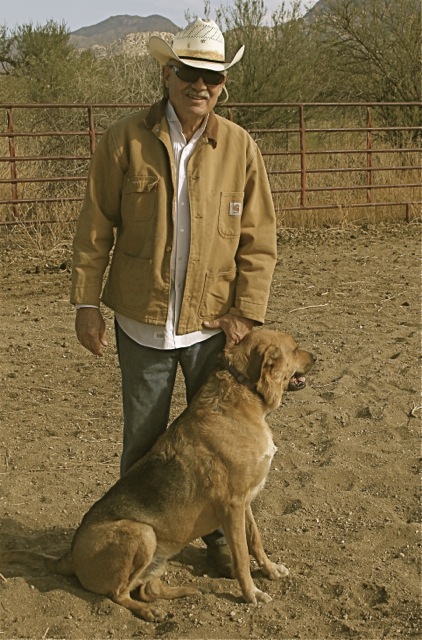
Whatever breed made up most of Lobo’s genetics, he was a watchdog. Perhaps his primary job was to protect his property, and most of all, his two-legged underlings.
His ideas about who was suspicious may have come from unfortunate early experiences, and this gave him the appearance of prejudice. He barked at anyone with dark skin, anyone wearing a cap, and anyone who was carrying a long tool like a rake over his shoulder. His bark was utterly terrifying—loud, persistent, and utterly convincing. The poor women who came to clean our house were terrified of him. And he was secretly terrified of anyone who was terrified. Their fear along with their big vacuum cleaner made the situation untenable, so he was banished to his outdoor pen every other Tuesday morning.
And so we worried every time a workman arrived; he was much more suspicious of men than women. But despite his brown skin, his habit of wearing a cap and the yard work he did for us, Lobo came to love Gabe. Gabe proved that where dogs (and plants) are concerned, love produces love. It didn’t take long before Gabe received the same disgustingly overly dramatic reception that Jon got. Whining, howling and barking as if it were Christmas morning every time one of them drove in the driveway made my eyes roll. I was lucky to get a couple of tail wags.
But, he would let me know he loved me by protecting me from anyone suspicious-looking who was working outside. He would be lying down calmly watching until I came outside. Then, the bark alarm would start.
Some people had a tough time winning him over—perhaps because of hidden dog fear that Lobo could read like a billboard. Friend Barb, who came every week to teach us yoga, took a long time turning that rough bark into a tail wag. Our friend and house sitter Cynthia, on the other hand, could produce almost the same greeting as Jon. Perhaps it was the baby talk she did with him, along with the stream of treats, walks and jin shin treatments. Friend Jennifer’s arrival was a close second. Was it their pretty faces? Chemistry?
Lobo lined up his tribe, which included some four-leggeds. Elsie, the pretty dog with the feathery tail next door was clearly his girlfriend. But up at our mountain cabin, he went for the blue-eyed husky, Nana, and then for her daughter, Tyin.
But none had a leg up over Jon. As the years went by, he would barely leave his side. If anyone could get him to do something he didn’t care to do, Jon would be the one. Unfortunately, Jon would let him lick off his plate, would have welcomed him up on the furniture if I hadn’t vetoed it, and would never leave him behind unless absolutely necessary. I was the mom—the one at home the most, the one he knew was there. But Jon was his star. His person. His only alpha.
Like the dog portrayed in the movie A Dog’s Tale (the true story of a dog who waited at the train station for ten years for his master to come home, after he died), Lobo waited every night for Jon’s return. Parked on his outdoor bed next to the driveway, he would refuse to come in for dinner until it was painfully obvious that his master was out of town. Sometimes I’d go out and tell him, “Jon’s coming!” and watch him look up at the gate.
I could have been jealous, but the truth is that since Jon never had children of his own, he may have never had that kind of unconditional, pure adoration. Perhaps one of Lobo’s lessons was that we crave this kind of love, and appreciate the way animals give it over and over, without a second thought.
I’d like the trainer who told me dogs have no emotions to have watched the Christmas morning performance and tell us that Christmas is just another day.
Tags: dogs as teachers, lessons from lobo, loyalty, Pamela Hale, unconditional love
Posted in dogs as teachers, happiness | 9 Comments »
Friday, February 22nd, 2013
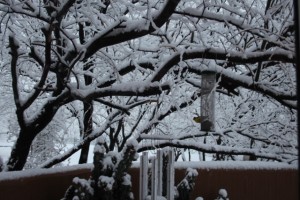
Those of you who live in AZ will understand why the snow storm we just had was a major miracle. If you live in Kansas City, you might not agree this week. But for desert dwellers in the middle of a long drought, water in any form is good news.
More importantly for my wild heart, the snow created a fairyland that made me feel about six. Sitting in my home office, I could feel my wild heart sitting up to take notice. “It’s turning white!” she said, anticipating an adventure.

Sure enough, after part one of the storm my husband came home and we put on our boots and went for a walk. Crunching along, halfway around our usual loop, it started to snow again. Slowly at first, then more and more intensely. We started to laugh. Slowly at first, then more and more intensely. Our dog began to prance. We were in the middle of a full-on snow storm.
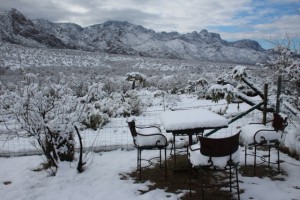
By the time it all ended, our table on the hill was uninhabitable, but my wild heart loved the scene. And here are some of the reasons:
- My wild heart loves surprises.
- My wild heart loves wildness in nature.
- My wild heart loves beauty.
- My wild heart loves transformation.
- My wild heart loves joy.
I got all these in one walk. There’s something to treasure, to consider, to keep.
And you? What does your wild heart love?
Tags: beauty, consciousness, creative imagination, inner landscape, Nature and the soul, perception, Photography, The Beauty Way
Posted in happiness, nature as mirror, Photography, shifting how we see, Tools for seeing ourselves, weather, winter | 5 Comments »
Monday, February 4th, 2013
The second process I’ll use to explore what my wild heart desires is photography. I went on a walk in Catalina State Park, which is a treasure right next to my house. (I know, my wild heart is already grateful.) I took some photos—not thinking too much about why, except I was attracted to that scene—and now I’ll dialogue with them.

Seeing the great Catalinas, touched by the setting sun, I remember that my wild heart’s desire is always to live near beauty, with beauty surrounding me, and to be on the Beauty Path. That is, if for some reason I find myself in a place that doesn’t seem beautiful, I will find beauty there, or create it. Thank you for reminding me of how much I love beauty.
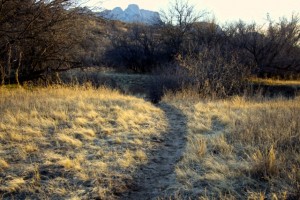
I am reminded that I am always looking for my path. That the exploration–the finding and following my path–is a lovely adventure in itself. My wild heart loves that exploration and isn’t nearly as attached to the destination or the end result as my mind and my ego. Another good reminder!

This scene reminds me that reflections–even in an ordinary rain puddle–can be lovely. The way nature is reflected is a treasure, if we just remember to look. My wild heart loves to find lovely reflections, both in nature and in my own inner landscape. She loves the process of taking time, of looking and remembering to remember. She wants me to always allow time for this.
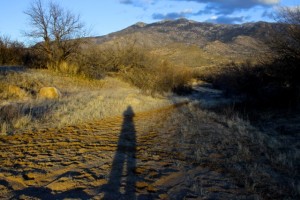
Finally, I stop and see myself–my shadow–in the landscape. What does this show about my wild heart? The photo tells me that my mind and ego tend to think my shadow–the parts of me that aren’t visible to me in “normal life”–show up in natural ways in order to be recognized and accepted. That means the parts of me that aren’t so nice and pretty are going to show up in my outer life through my relationships, and they’ll also show up in my inner landscape. And that is a good thing. My wild heart doesn’t care if I have imperfections. She’s all about discovery, exploration, venturing into uncharted territory. She says we can all have wonderful discoveries when our shadow shows up. Sometimes these involve healing old wounds and other times they involve seeing and recognizing our gifts.
What do these four photographs say to you about your own wild heart? I invite your comments!
Tags: beauty, consciousness, creative imagination, creativity and empowerment, inner landscape, Nature and the soul, perception, Photography, The Beauty Way
Posted in bringing out your gifts, consciousness, Gaia, happiness, healing, Imagination, inner landscape, loving ourselves, nature as mirror, Photography, seeing oneself, shifting how we see, spiritual practices, The Beauty Path, Tools for seeing ourselves | 4 Comments »
Tuesday, October 9th, 2012

It’s so easy and delicious for me to sink onto a place of beauty in nature and feel safe in that “All Is One” feeling. Next to ocean, or stream, or wind through the pines I am reminded of the life force that courses through all things. I am in my safe landing space at those times.
And then we know there are other moments. Moments that suck. Moments that are almost intolerable. Moments when we don’t want to be here. Moments when we feel like life must be against us. These moments do not feel like safe landing spaces.
So what to do? Especially since those ‘other moments” are when we need a safe landing space the very most.
Well, I say we create beauty. We must.
I love to talk about Victor Frankl, because he is the most extreme example I can come up with of a human who could create beauty out of the most meager ingredients. A concentration camp survivor whose whole family was exterminated, he credited his survival to his decision to find meaning in every day.
If he could do that in those circumstances, surely I can do it in mine.
But how, in those moments of despair, frustration, fear, or anger do we create beauty? There is a lot of ugliness in the world, after all.
I think it’s a choice. About how to see. Without being a Polyanna, without denying, we can choose to see beauty.
I can choose to find the beauty in an ordinary task like peeling a vegetable that God made, or even cleaning a toilet I’m lucky to have. I can choose to find beauty in weeding a garden where I’m making room for new life. I can choose to seek out the beauty that accompanies some of the worst tragedies, where in the midst of great loss there is some moment of exquisite love. I can choose to not be blind, but just to see “through a different lens.”
Maybe this is part of our work on earth. At least it makes our journey here more lovely.
Do it for you. Create beauty just to make your day better.
Do it for someone else. See if that doesn’t make your day better too.
See if when you create beauty, it doesn’t make you feel safe somehow. Safe in the fact that you are a creator. Safe in the fact that there is beauty in the first place. Safe in the fact that creating beauty is a well-worn path. A sacred one. One which has eternity in it.
Ah, now you have landed. In a beautiful place. On solid ground.
Tags: beauty, consciousness, creative imagination, creativity and empowerment, Flying, Flying Lessons: How to Be the Pilot of Your Own Life, Flying metaphor, inner peace, musings, Nature and the soul, perception, Photography, spiritual practice, The Beauty Way
Posted in aviation, coaching, conscious evolution, consciousness, creative imagination, creativity and empowerment, Flying, happiness, healing, Imagination, nature as mirror, Photography, seeing oneself, shifting how we see, spiritual practices, The Beauty Path, Tools for seeing ourselves | 5 Comments »
Friday, June 22nd, 2012
I’ve been away from blogging for awhile, and I’m aware that it’s partly because I suspected I might just be whistling in the wind. Even though I get some nice comments from people, I don’t have a great deal of evidence that a lot of people read my blog.
Which brings up the question, what does a creative endeavor mean if no one is receiving it? Or another way to put it is, what does a creative endeavor mean to the artist if there is no evident feedback? This has been a dilemma for artists of all media for millenia.
I’m really not complaining, because my ego got stroked big time recently when my book, Flying Lessons: How to Be the Pilot of Your Own Life, received a gold medal IPPY (Independent and small press publishers) award in the self-help category. I have to say, that felt really good! And, many readers are telling me how much the book means to them, and even buying copies for friends and family.
In reflecting on the boost this award and reader responses have given me, I’m wondering what role outer feedback plays in our success. I’m musing now on flying lesson #5, Communicate with the Controllers. In this case, the controllers would be the audience, or buyers or critics who give the artist feedback on the “worth” of her creation.
Should those opinions define us and be the bottom line measurement of our creative ability? I sure hope not, since there are books on the best seller list at this moment whose literary value I would question, for sure. And, there are some fabulous songs out there that aren’t being played on the radio.
But we can’t honestly discount feedback, either. Even when we’ve evolved beyond acting out of ego into a desire to serve, the audience counts. What “controls” the creative artist is a mix of his inner drive and desires and the way in which the world receives his offerings.
It’s the same, I suspect, whether we are mothering, making lattes or selling large scale paintings in a gallery. The motivation comes from inside. And, if the creative person is not “seen” by others, it’s easy for the spirit behind the work to wane.
Hopefully, these two forces work together. The woman I can’t forget, who used to work at the Starbuck’s in my local market, is someone who added to my life. Her smile, her humor, her energy came from a place within her that clearly desires to connect and enrich others’ lives. That spirit motivated me, of course, to buy more drinks from her and to emulate her way of being with others. A win/win.
And so, armed with my gold medal and nourished by that positive feedback, I’m back to blogging. I look forward to trying to serve you some nourishment that will quench your spiritual thirst, make you think, urge you to smile, perhaps bring a tear to your eye, and bring out that spirit within you that longs to create and connect.

Tags: consciousness, creativity and empowerment, Flying Lessons: How to Be the Pilot of Your Own Life, Flying metaphor, Pamela Hale
Posted in aviation, bringing out your gifts, coaching, conscious evolution, Creativity, creativity and empowerment, Flying, happiness, seeing oneself, self image, shifting how we see | No Comments »
Sunday, March 18th, 2012

I remember flying along this gorgeous coastline in Baja, Mexico, with my husband Jon. It was before I got my pilot’s license, and so when he urged me to stop photographing and take the controls, I got instant butterflies. 95% of me wanted to fly, but the 5% that was terrified had the capability of ruining everything.
This makes me think of the beginning of my career, when I was a classroom teacher worried about maintaining discipline. Even on days when I had 95% of the class involved and focused, I was always afraid of that 5% that might take those controls away from me.
If “flying” is a metaphor for the 95% of us that knows how to break free of gravity and soar, we still have to learn to deal with the 5% that suspects we might crash at any moment. I call this “communicating with the controllers,” which is Lesson 5 in my book, Flying Lessons.
The challenge of this lesson is dealing with negative feedback. That might include the kind of inner voice I heard when my husband urged me to take the controls and I was afraid I couldn’t do it. Or, it might be outer feedback, like the kind I would get from disruptive students.
I would submit that our reaction to both kinds is fear: fear of the fear we feel, or fear that we will not be able to stay in control. Or fear that we were incapable all along; thinking we were was just a lie. And fear can hijack a good intent, a calm mind, an open heart and a good experience.
The lesson I learned from Clio, my flight instructor, was about discernment. Which voices are telling the truth that will keep you safe and set you free? And where is your true voice, which you need to use when standing up for yourself is the answer.
Here’s a summary of Clio’s advice:
1. Be kind. The 5% may be afraid. Fear can make them (whether they are outer or inner voices) say terrible things. Take that into consideration.
2. Be fair. Remember, they are the 5%. Are you listening to the 95%, or are they just invisible, their hands folded politely on their desks, their voices muffled behind their modest smiles…What if you asked them to raise their voices in song?
3. Ask for help. Ask your partner, your friend, your angels, your guides, your God, whomever you trust the most for help. For listening. For caring. For hugs. For company. The 95% of the controllers are trying to help you survive.
4. Keep the whole journey in mind. Remember, it’s this part that is hard. The big picture journey probably has a much more beautiful arc to it.
5. Remember, everything is relative. You sometimes think the world is coming to an end. When yours looks like that, so does the larger one. Still, there are those other times when all is glowing, when the leaves of every tree are on fire with sunlight, and when the moon is huge and white and all-knowing. When life is holy. When you are perfect, just as you are.
Tags: consciousness, Flying, Flying metaphor, inner peace, living today, managing fear, perception, Photography, Self, spiritual practice, ups and downs
Posted in aviation, bringing out your gifts, children as teachers, coaching, conscious evolution, consciousness, creativity and empowerment, Flying, happiness, healing, loving ourselves, nature as mirror, nourishing ourselves, Photography, seeing oneself, self image, self-healing, shifting how we see, shifting paradigms, spiritual practices, Tools for seeing ourselves | 2 Comments »
Tuesday, January 24th, 2012

Sometimes I cringe when I meet someone who asks me what I do. Answering either “life coach” or certainly “energy medicine practitioner” or for sure, “shamanic practitioner” can lead to immediate Eyes Glazing Over Syndrome.
Sometimes I do better when I tell a client story, but the best approach is asking questions. Like, “Have you ever had the feeling that something is missing in your life, even if you’ve read a lot of books, had therapy or tried meditating?” (At this point, I am checking for “Woo Woo, Checking Out Now Syndrome.)
But I persist. “Do you ever feel confused about your purpose? Or feel that your passion for your life has gone flat?”
Even though such complaints are vague, most of us have experienced them. Someone who says “Absolutely not” would probably not want life coaching or any personal development enrichment.
In reality, we have all experienced feelings that some might call burnout, and others might describe as being out of balance. Even someone who has never quite found that path, that center, usually can recognize these symptoms. The vocabulary isn’t important. And so…what?
I would call the feeling of being in our center, on our path, feeling passion and purpose “the pilot’s seat.” And I would say that the one who has taken the pilot’s seat in such moments must be the essential self. The one who is all about our life force, or soul.
Sometimes the essential self manages to take the pilot’s seat “by accident,” or really without our effort. In those moments we might call grace, we simply know and we simply are.
When you’ve been there, it’s painful to be dislodged from the pilot’s seat, or to have it commandeered by sub-personalities, or by the ego, who is not well-connected to essence.
Sometimes just the awareness of being off-center is enough to correct the situation. Other times, we need help. We need tools. Here are some to consider:
- Deep talk, soul sharing with a friend or advisor who listens well
- Traveling into invisible realms for guidance, through meditation, prayer, dreams or shamanic journeying—or my Sand Spirits Insight Cards!
- Any breathwork or meditation system that leads you back into your heart
- Asking the Great Mystery for help
- Work with changing old beliefs and releasing old patterns
If any of this resonates with you, I invite you to call me for a complementary phone consultation. Or if this has helped you remember your own tools, please add your comment!
Tags: Being, centering, centering techniques, consciousness, Essence, Flying, Flying metaphor, inner landscape, living today, managing change, meditation, perception, Photography, Sand Spirit Insight Cards, spiritual practice
Posted in bringing out your gifts, centering techniques, coaching, conscious evolution, consciousness, Dreams, Flying, happiness, healing, Imagination, inner landscape, meditation, mindfulness, Photography, returning to essence, Sand Spirit Insight Cards, seeing oneself, self-healing, shifting how we see, shifting paradigms, spiritual practices, Tools for seeing ourselves | No Comments »
Tuesday, January 3rd, 2012
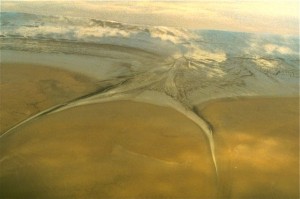
When I walk on the beautiful land in the Sutherland Valley, beneath the Catalina Mountains, the land reminds me that Mother Earth has a heartbeat, a rhythm. Being in nature attunes my body to her rhythm and reminds me of my own natural pace. So does meditation—it is a way of stopping to check in with the Source, and with my own body/mind, and re-calibrating.
I need to change my “attitude,”—an aviation term for the angle of the airplane– to pull the nose of my airplane up a bit and slow my speed.
When I think of the idea of slowing my pace, my “small mind” immediately panics at the thought. What will I miss? What will I not accomplish?
Fortunately my “larger mind” responds by asking, “Where are you going so fast? What is your destination or goal that is so crucial? Isn’t the journey the point?”
My small mind says nothing.
I remember Thich Nhat Hahn’s cautions about our pace, his advice about mindful walking and mindful eating and avoiding multi-tasking.
My small mind points out how many things I accomplish by multi-tasking. Is that really true? Recent research points out that our brains don’t operate at maximum efficiency when we do more than one thing at a time. Maybe we are sacrificing focus, intensity and depth of thought, excellence in problem-solving.
Perhaps I suffer from the aviator’s dreaded plague, “get-there-itis,” the disease that leads to unwise decisions like flying too late, or into bad weather, or when sick, or in conditions outside our expertise. If we crash, we might ask ourselves what was so important about that destination and how much time we really saved.
If I take time to gaze out the window, perhaps I’ll really see something like the scene in the photo of the water and cloud formations along the Sea of Cortez. What’s the hurry, really?
These are thoughts each of us must bring to consciousness as we pilot our way through a year that may challenge us to drop old patterns, to take responsibility for our own energy, to ask treasured family and friends to support us as responsible pilots who have taken the left seat. We may not be able to manage the strong winds of life, but we can manage ourselves.
What are your thoughts? Interact with us at Facebook.com/FlyingLessons!
Tags: Being, consciousness, Flying, Flying metaphor, inner peace, living today, managing change, meditation, musings, Nature and the soul, new life, own pace, Photography, spiritual practice, The Beauty Way
Posted in aviation, Being, coaching, conscious evolution, consciousness, Flying, happiness, healing, health, inner landscape, loving ourselves, managing change, meditation, mindfulness, new life, not doing, nourishing ourselves, Photography, returning to essence, seeing oneself, self-healing, shifting how we see, shifting paradigms, spiritual practices, The Beauty Path, Tools for seeing ourselves | No Comments »















